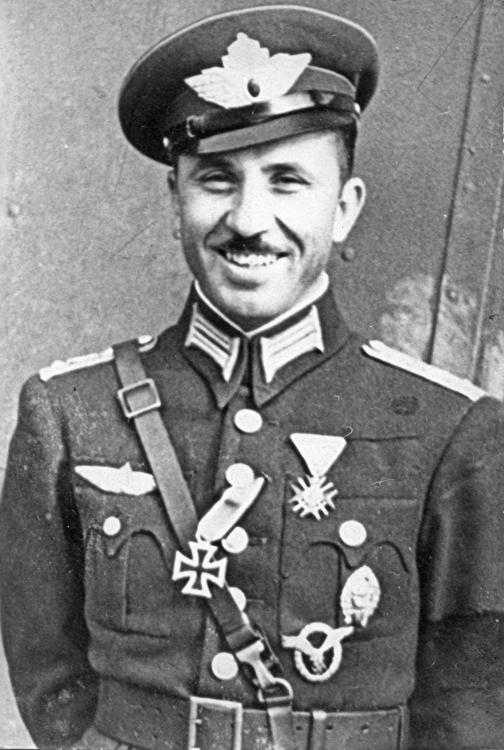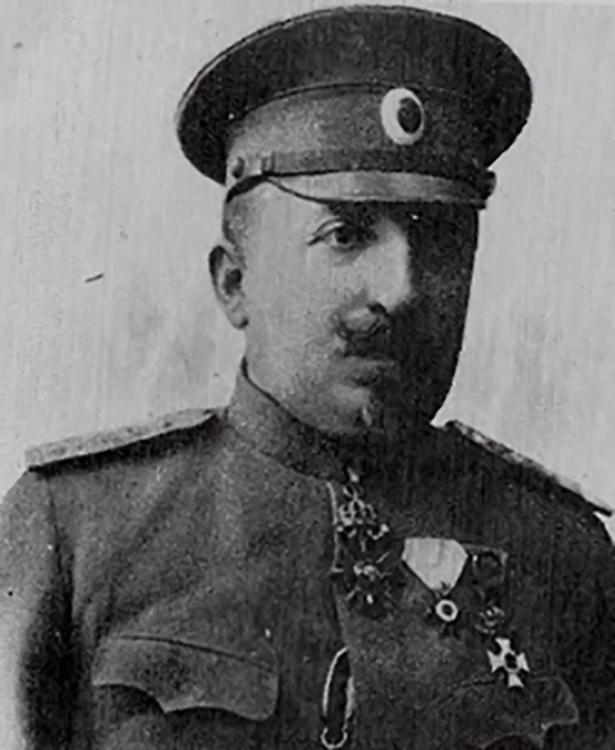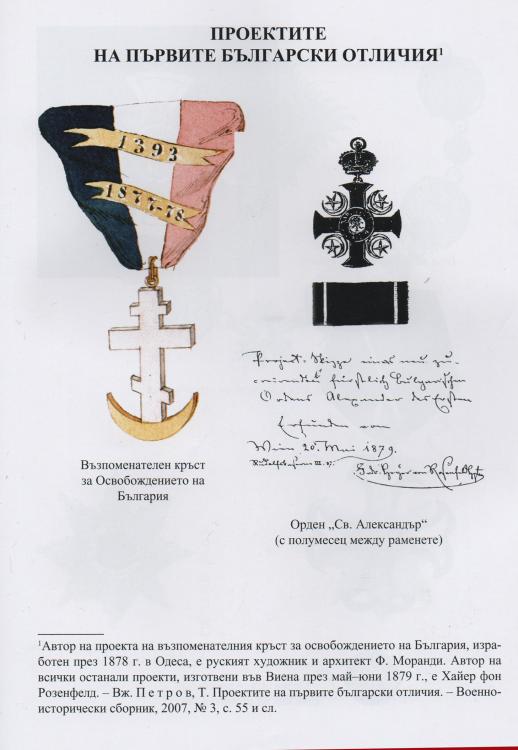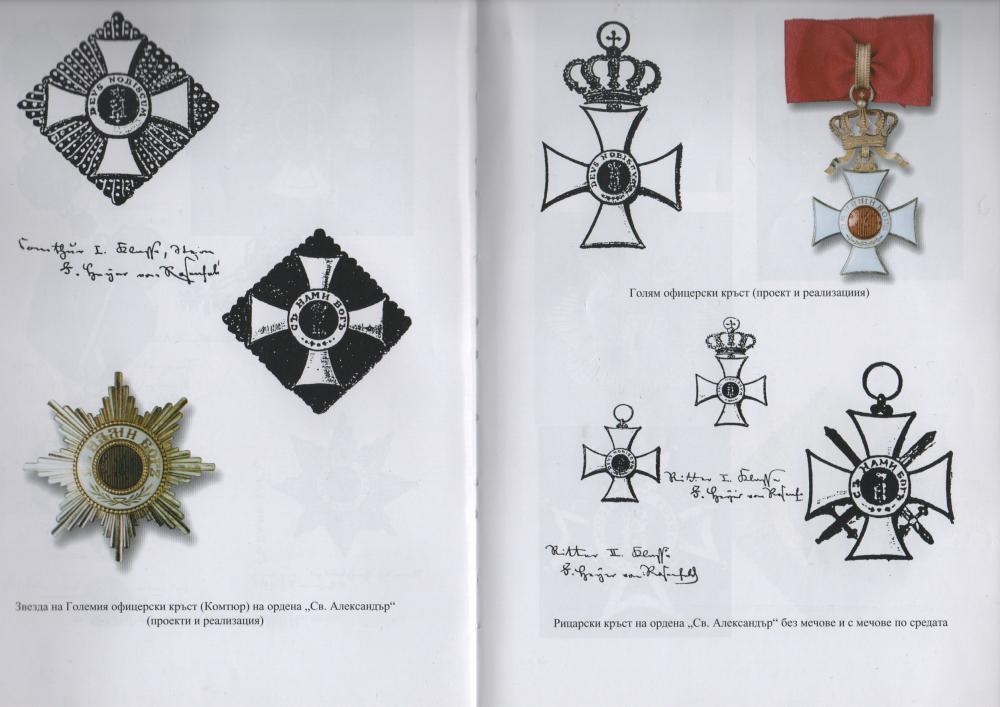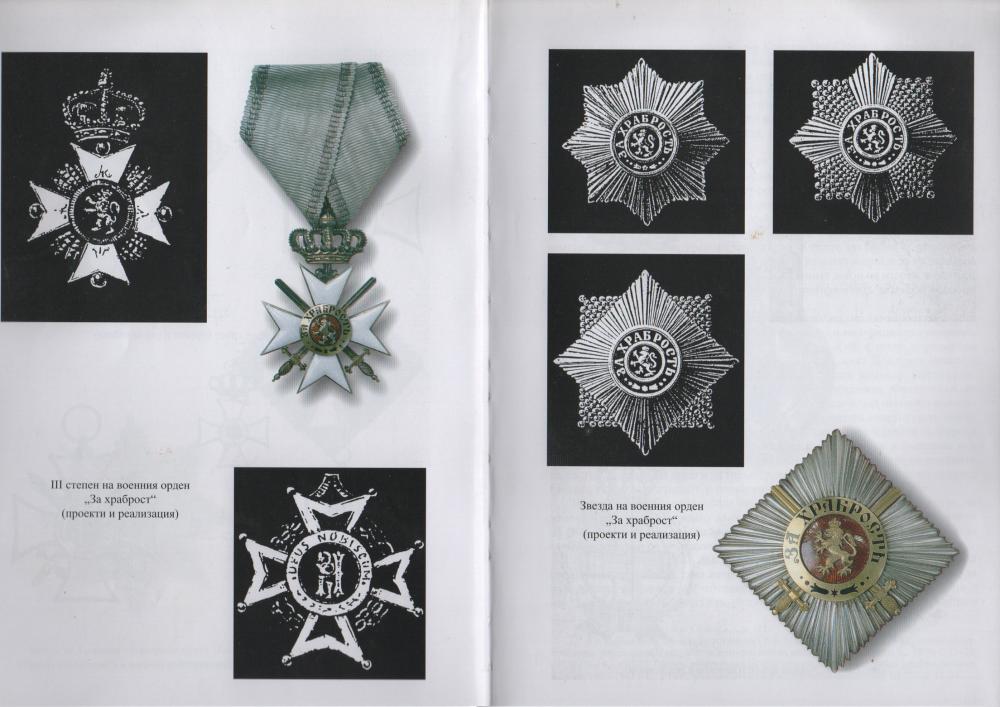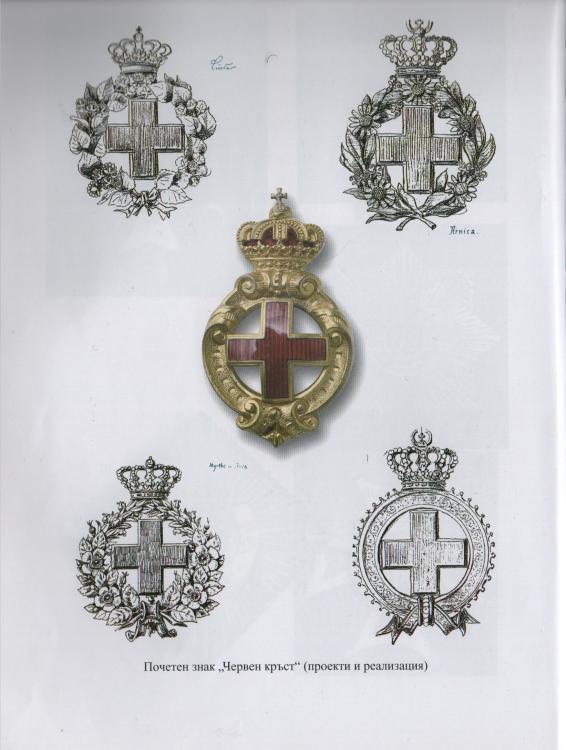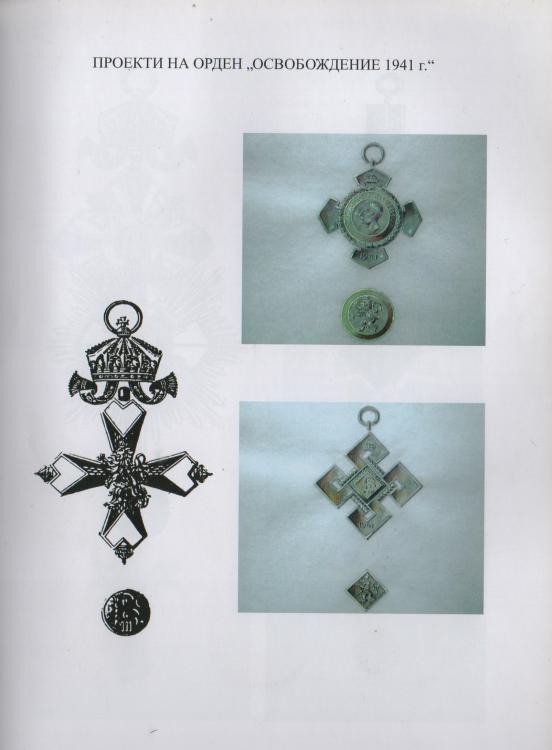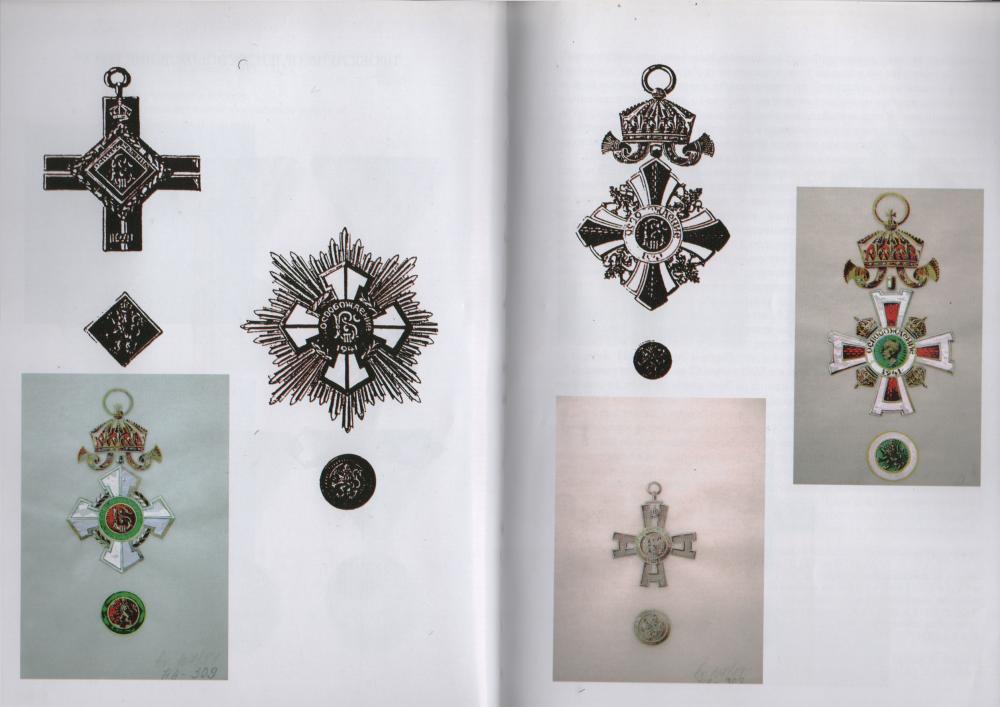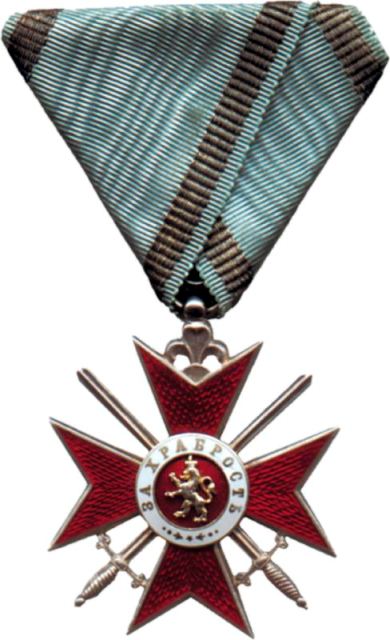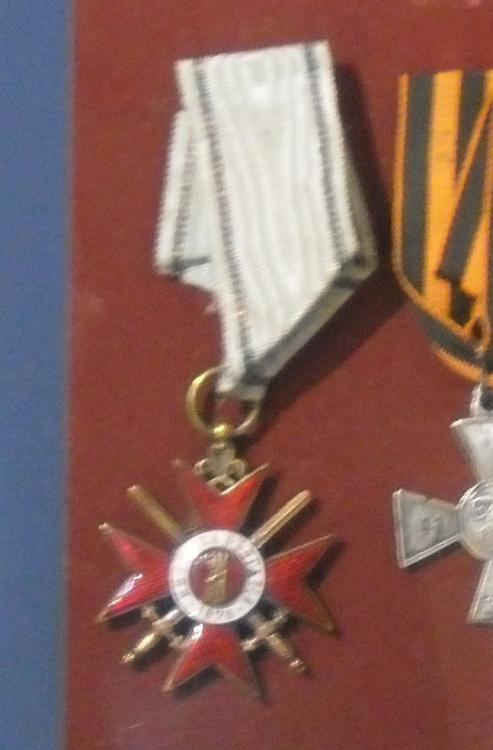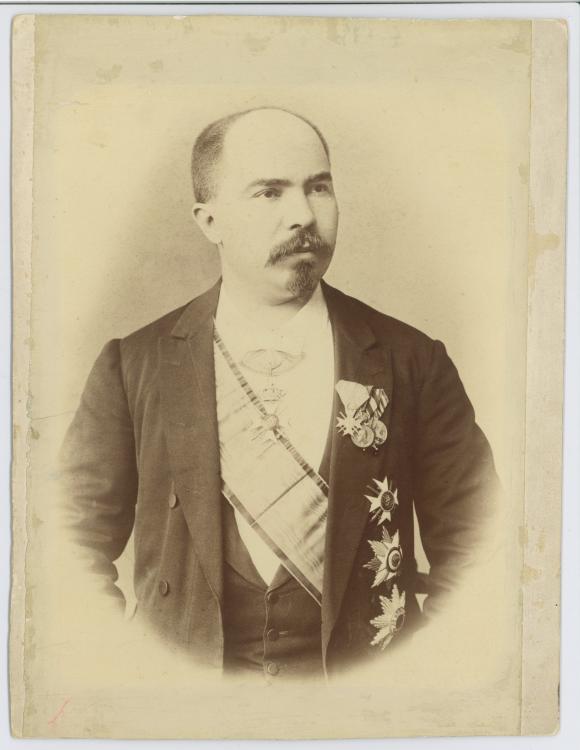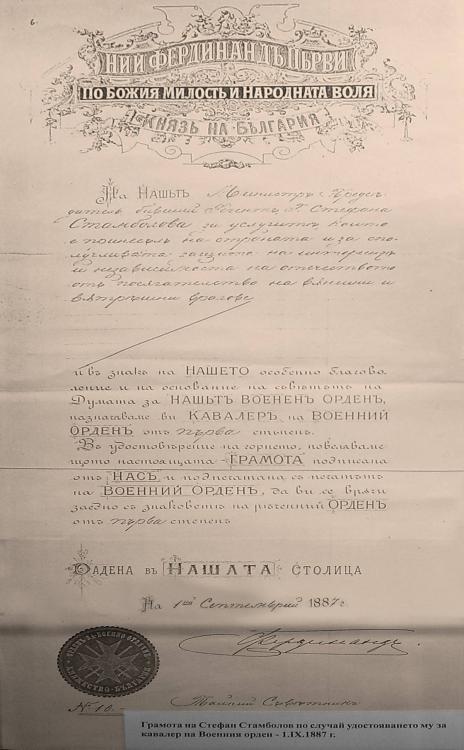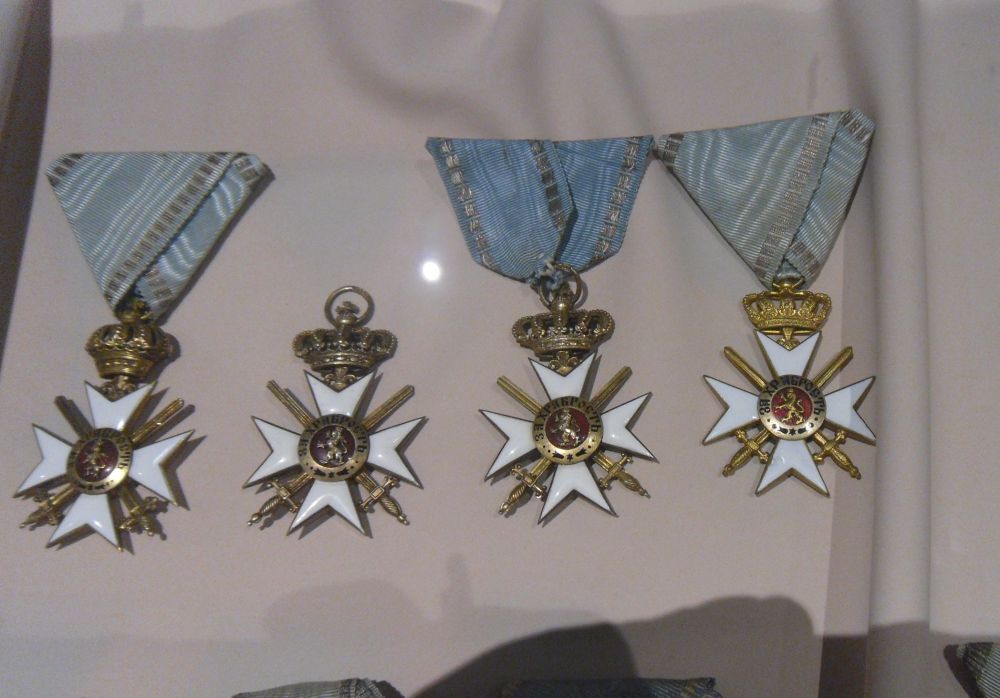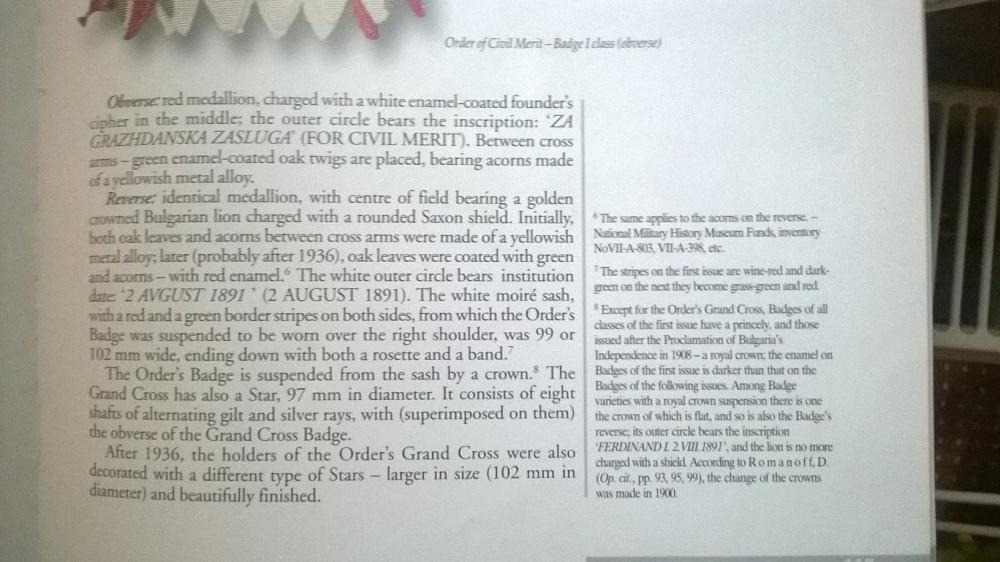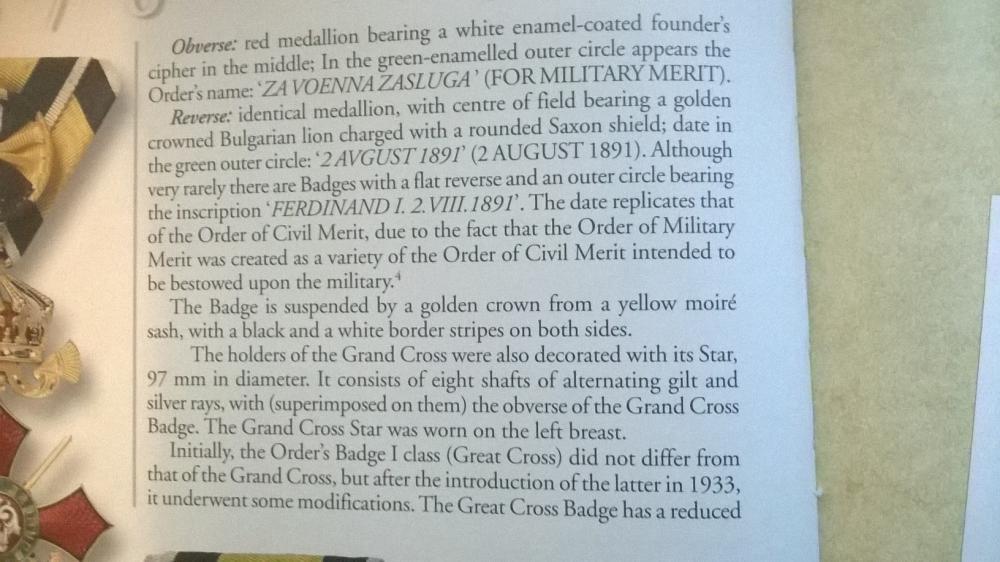-
Posts
232 -
Joined
-
Last visited
Content Type
Profiles
Forums
Blogs
Gallery
Events
Store
Everything posted by ilieff
-
Hi all, Allow me to share with you some interesting information about General Stoyan Stoyanov - a WW2 Bulgarian ace, pilot instructor and later deputy-commander of the anti-aircraft system of Socialist Bulgaria. Due to the limited involvement of Bulgaria during the initial stages of the war, the fighter pilots were the first to actually engage in combat with the Western allies. Stoyanov and his fellow fighter pilots were defending Bulgarian air space from the American and British planes which were bombing the oil refineries in Ploesti or simply bombing the capital Sofia. On 1st August 1943 Stoyanov shoots down an American B-24 and another B-24 is damaged severely. Six days later, he is invited to the Royal palaca where King Bors III personally presents him with the 4th Class 2nd Grade of the Order "For Bravery". According to the mainstream sources, this is the first decoration of a Bulgarian officer with the Military order after the end of the Great war. Soon after that, he is also decorated with the Iron Cross 2nd Class by the German command (a scan of the actual document is available on Wikipedia). In the period between August 1943 and September 1944 Stoyanov scores 15 air victories which earns him the 4th Class 1st Grade of the Military order. Date of decoration not currently known. After the Communist coup in September 1944, Stoyanov continues to be a pilot instructor for the new Bulgarian pilots. At this time, he already has the effigy of a living legend for the Bulgarian air force. In November 1944, gen Vladimir Stoychev takes part in the decoration of all surviving pilots near Sofia. Stoyanov is promoted to major and decorated with the 3rd Class 2nd Grade (again, the date of actual decoration is unknown), thus becoming the sole Bulgarian officer to receive three orders "For Bravery" during the Second World war. He has a very interesting and dynamic life. If you are interested I can share some info. In 1972 he manages to publish memoirs which have been greatly censored by the communist censorship. His book has been re-published several times since but is still very rare to find (I haven't been able to read the book yet). In 1992 he is officially promoted to general by president Zhelev. On 13th Match 1997 Major-General Stoyanov passes away. He is honoured with a military funeral with the whole General staff of the Air Force attending it. On the photographs: - Stoyanov shortly after being decorated with the Iron Cross - Stoyanov's decorations on display during his funeral (understandably, his German decorations are not on display)
-
That's what happens when people wash their ribbons along with the white laundry. On the serious side, there are a number of reasons why the colours might differ from ribbon to ribbon: 1) Ribbons do lose their colour with time, especially if kept in not very suitable places. Thus, a red ribbon might look orange afrer just a coulple of decades. 2) Different makers used different suppliers of ribbons and often they varied in their colour/tint. Numerous examples throughout Europe. 3) Poor materials used - e.g. during wartime years, the materials used tend to be of a lower quality (being cheaper), hence the colouring could fade away more quickly, compared to other examples. 4) Etc. etc. I am not an expert in foreign decorations, but my suspicion is that the top ribbon on the above image is a replacement/copy ribbon actually, while the 'organge' one appears to be a genuine one. Please correct me if I am wrong.
-

Bulgaria FAKE BULGARIAN ORDERS ON THE MARKET
ilieff replied to Graf's topic in Central & Eastern European States
Original awards were NOT 'casted'. They were minted (press-stamped) and because of this, their reverse and especially edges are very smooth and straight - something which is a huge give-away for fake decorations (which are usually casted) whose reverses are covered with little holes (due to the trapped air while casting) and the edges are more rounded due to hand-sanding the imperfections of the cast. This is visible on the above images too. Even so, I've seen some obviously faked stars for sale, which do have a smooth texture on the reverse. This makes me conclude that either (1) they used original parts/bases OR (2) that professional machines and/or dies were used for the production itself (which is really bad if true). -

Bulgaria Medal for Merit and Order for Merit
ilieff replied to Graf's topic in Central & Eastern European States
HI all, Graf, may I elaborate and correct you on some of your points, The Order of Merit had only two classes - Gold and Silver badges (also called 1st and 2nd class) but due to the fact that the 1st class has only been presented to a dozen of men (or so), the general assumption is that the Order of Merit represents a silver badge, used for decoration of army officers (predominantly). As for the Medal of Merit, indeed it came into three classes. It was used for decoration of a broad range of professionals, including military men. The gold medal is indeed the rarest of things. It is a symbol of a great merit and its holders were the highest ranking officials in the country or similar in rank foreigners. Todor Petrov, citing Vl. Vladimirov, writes about 69 golden medals being awarded by 1940 (presumably, the majority of these abroad). I am prone to think this figure is plausible, or at least near the actual number of awarded men. Unfortunately, due to the fact that the original golden medals were simply gilded (with silver of bronze base), there is a certain number of faked golden medals out there. The same applies (perhaps in greater extent) to the golden Orders of Merit. It's a pity. I really like your two golden medals Graf. Congrats! Have these been given to German nationals? Are you able to share any background information? Here's an original illustration on behalf of the Chancellery of Bulgarian orders (circa 1904), showing the classes of both order and medal. Regards, order_and_medal_of_merit.pdf -

Bulgaria Bulgarian Order for Bravery 1941
ilieff replied to Graf's topic in Central & Eastern European States
According to one source, for the period of 1880-1918, about 270 Bulgarians have been decorated with the third class (2nd grade), of whom nearly 170 during WW1. However, this source is most certainly not fully accurate and I assume these numbers could be greater. Sadly, there's no data of the number of foreign nationals given this class. Best, -

Bulgaria Bulgarian Order for Bravery 1941
ilieff replied to Graf's topic in Central & Eastern European States
I hope it's not too off-topic: A very poor quality image of Major General doctor Ivan Batsarov who appears to display his IV class 2nd grade order without swords. Even though I haven't specifically attempted to try to find an image where the Military order w/o swords is being worn, I believe that this is the sole publicly available image in this regard so far. Regards, I -

Bulgaria Bulgarian Order for Bravery 1941
ilieff replied to Graf's topic in Central & Eastern European States
It is a known fact that the Marshall was decorated with the 1st class Order "For Bravery" but I cannot find any reference for the exact date. Sources vaguely indicate late March 1945 as one of the first mass decoration of Soviet army men but it is highly possible that individual decorations did take place prior to this date, too. It is important to note that the 'old-style' decision-making for the Military order (i.e. Order Council) has been disrupted and even suspended in the later years of the War, especially for the privilege of awarding the 4th class orders which were now given upon the personal decision of the army group commander. In this sense, we cannot say with certainty that any decorations with 1st, 2nd, etc. classes were documented officially (as it should under the proper practice of the Order Council) at that time. A few facts which some of you might find interesting: As early as late September 1944, the old stock of orders and medals at the Chancellery has been exhausted and the Chancellery hires Berdj Kesterdjieff's (alternatively spelt Berdz Kesterdziev) factory to mint Soldiers' crosses and to re-silver some old and worn ones. Two weeks later, due to the high demand, Georgi Shishmanov's factory joins in, too. It had to repair broken and deformed awards. November 29th, Two other Sofia-based companies have been employed with award manufacturing - Strahil Miloshev' factory and the Onik Chakarov and Onik Simonyan's joint corporation. They were to mint 4th classes of the Military order (according to Petrov's book, 3,000 of first grade and 500 of the second grade). This is the so called 1944-1945 emission you all know, featuring a five-pointed star on the ring. In April 1945, the Ministry of War considers that the number of Bravery orders, given so far, is unacceptably high and reminds the commander-in-chief of 1st Army, Gen. Stoychev*, that Orders of St Alexander and the National Order of Military Merit also have war-time variations and these should be properly used for decoration of battlefield merits, too. However, in the original text we can sense that the Minister of War has little knowledge as to when St Alexander is given with swords and also which is the war and peace time ribbons for the Order of Military merit. During the later stages of the war, the 6th class of the Order of Military merit has been 'generously' awarded to various military ranks, thus ignoring (in a great extent) the bronze and silver medal of merit. And some numbers from Petrov's book: People awarded with 3rd and 4th class (both 1st and 2nd grade) for the war of 1944-1945 totalled 3,387 (which is 2.82% of the total number of the military). For the same period, the total number of military men awarded with the wartime decorations is 12,974. No data present for the 1st and 2nd class decorations of the Military order. *Gen Stoychev has been decorated with 4th, 3rd and 2nd class (with crown suspension) of the Military Order. Wikipedia states that he's also been decorated with the 1st class but I cannot find a photograph where he's displaying it. I am thinking they might be referencing the later socialist order "For Bravery" instead. -

Website for Royal Bulgarian awards
ilieff replied to ilieff's topic in Central & Eastern European States
Thanks, Igor. Wow -
Hi all, Considering that the majority of you are not fluent in Bulgarian language, I wanted to share with you some unique images from Todor Petrov's book on the history of the Bulgarian system of decorations (published in 2011, ISBN 978-954-509-445-3) which covers the period of 1878-2010. Unlike his book in English which you are familiar with, this one is more focused on text rather than images and gives some very nice details which might be quite useful for collectors, too. Apart from the loads of interesting and little know information, in the book are also included some unsuccessful design concepts for the Bulgarian awards. Images #1, #2 and #3 show some of the original black and white sketches of the Order of St Alexander, while #4 - the Military Order. Their author is the designer of all the early Bulgarian orders - Friedrich Heyer von Rosenfeld (decorated for his contributions with Order of St Alexadner IV class, Order of Civil Merit III class and silver Medal for Science and Art). He is also the designer of the new Bulgarian crown of 1891. Image #5 is again by von Rosenfeld - the possible variants of the Red Cross badge. Further on, images #6, #7 and #8 represent blueprints for a WW2-era award [supposedly intended as an order]. It bears the effigy of the King, the year 1941 and the word 'Liberation' signifying the unification of Bulgaria in this year. The author(s) of this projects remain unknown and it's also not clear why this decoration has never been approved. I find these images very interesting and would like to hear what you think of them? If there's enough interest, I will try to elaborate on the topic by describing what's covered in the book itself. Regards, Ilieff EDIT: Images got mixed up. I will add in numbers in between Image 7: Image 6: Image 5: Image 4: Image 3: Image 2: Image 1: Image 8:
-

Bulgaria Bulgarian Order for Bravery 1941
ilieff replied to Graf's topic in Central & Eastern European States
Hi all, Just a side note on the 'doctor' crosses. A very large number of these crosses have their ribbon folded in a reversed way. I wonder if this is how they came originally and are meant to be worn? Ilieff -

Bulgarian Bravery order - early Austrian made
ilieff replied to new world's topic in Central & Eastern European States
Hi all, Firstly, about the 'Swedish collection' - well spotted Vazov. I just want to note that the neck crosses of 1st class and 2nd class are not identical (one is smaller) and that, as far as I know, there are confirmed 2nd classes from the 'three-dots' emission (Graf posted in another thread a photo of a republican neck badge which in essence is an amended 'Boris III' issue order). What I find even more interesting about the 'Swedish collection' is the 'Alexander' box on the left - it looks slightly larger than the generic boxes we all know. I wonder if it's a box for the 2nd class or simply an optical illusion. Now for the orders with the lily - I agree with the above. However, it baffles me how come there is so much variance in design within a single and very limited edition. There are a couple of images, which indicate even more differences. The first one (from the archive of eMedals) shows a badge with strange swords and again smooth arms, while the second image (from the Union of Collectors in Bulgaria) shows a badge, similar to one shown on the above images but the bottom of the lily is solid/closed as opposed to the open-design of the rest. How very bizarre!? Ilieff -

Bulgaria Bulgarian Order for Bravery 1941
ilieff replied to Graf's topic in Central & Eastern European States
Vazov, I suspect that the '1941' cross without swords which is shown by Prof. Pavlov in his book is a digitally altered image for presentation purposes only (a give-away sign is the ribbon which has been copied from another image). I won't believe in the existence of an actual '1941 doctor' until I see a photographic proof. Sorry for being pessimistic. Ilieff -

Bulgaria FAKE BULGARIAN ORDERS ON THE MARKET
ilieff replied to Graf's topic in Central & Eastern European States
I agree with Graf that it's the first impression that's the key. The third class first grade shown above is obviously a fake though I admire the time and effort which fakers put into their Frankensteins. I hope that no collectors purchase these items. Unfortunately, a certain number of these fakers are probably reading forums too, so I'd suggest that we don't give them any more details as to how they can improve their 'work'. Fingers crossed! -

Bulgarian Bravery order - early Austrian made
ilieff replied to new world's topic in Central & Eastern European States
Dear all, I wanted to elaborate on the topic of orders with lilies on top. I've heard or read several theories for the existence of the so called orders with the lily. Here are some of them: a/ Theory number one states that these pieces were privately made replacements for the original orders b/ Number two states that these crosses are actually part of a very limited in numbers emission (probably prior to or during the Balkan wars) c/ Third theory suggests that these were designated to be an unofficial mark of distinction for the personal grace and endorsement on behalf of the Monarch (hence the lily as a symbol of Ferdinand's Imperial French background). While I cannot write with certainty about a/, my feeling is that these were not privately-made. B/ sounds more plausible but it's not true, as there are visible differences between the samples, plus some of them are marked with 'seven dots' and some are marked with '1915' on the ring. In addition, some have decorative notches on their sides, while others don't. The only explanation for these variances is that these have been manufactured in at least two different batches, possibly by the same company but then again their larger size, in comparison to the generic 4th class badges, is making me feel dubious. While flickering through some images I took while in the National Military History museum, I've noticed the below photograph. Even though the quality is really really bad, you can recognise that this is a generic 'seven dots' bronze (once silvered, I suppose) 4th class but with a lily-shaped ear instead. This prompts me to ask myself whether the lily is only some sort of an elaborate loop or is it instead some sort of a non-official mark of distinction. What do you think? Regards, Ilieff -

Bulgarian Bravery order - early Austrian made
ilieff replied to new world's topic in Central & Eastern European States
Dear all, Here's a photograph of the Prime-minister and regent Stefan Stambolov. He's one of the few people presented with the first class set (along with the other two regents). His badge is obviously a generic example with green-enamelled ring as opposed to a gilded one. In addition, below is a photograph of the awarding certificate given to him and singed by the new Monarch. It's dated 1st September 1887 and should be a genuine document, even though I cannot prodive you with its source. The two images together indicate that the green enamelled orders started to be awarded [not later than September] in 1887, while we know for a fact that the commanders of the Serbo-Bulgarian war (e.g. General Nikolaev, General Petrov, etc) have been decorated a year earlier (in 1886) with second classes of the same order but their badges are having gilded outer rings instead. This points to the conclusion that the 'gilded ring' design has been discontinued in mid 1886 (with few exceptions). Another clue is the unique rounded breast star, worn by Alexander I, which also features green enamel. Of course, not everything is that straight-forward when it comes to the highest classes of Bulgarian orders. I think that the highest classes were being given only by the Monarchs grace (especially during Ferdinand's reign) and in the majority of cases personally by Him. A contemporary of the Prince wrote in his memoirs that Ferdinand had his own stash with orders in stock, independantly from the Chancellary of Bulgarian orders (though we cannot be certain of the purpose of these 'stashed' decorations). Also, I think that the 'gilded ring' orders were not only of Imperial Russian manufacure. Some decorations of the Battenberg period were indeed Austrian made and logically, certain numbers of the Order "For Bravery" could well be, too, considering the suspended diplomatic relations with Russia after September 1885 and the need for more orders in early 1886. -

Bulgarian Bravery order - early Austrian made
ilieff replied to new world's topic in Central & Eastern European States
Hi Vazov, Here's a slightly more clear image of the same display at the museum (yes, lighting is very limited in there, so any photos would be dim and blurry). I've also noticed the unusual gilded ring example. Prince Romanoff shows such examples in his book. I do not have any information in this regard though. These must be either part of a limited Battenberg/Early Ferdinand batch which obviously has features of both the early and late issues, or a generic piece with changed rings (which is very unlikely). Ilieff -

Website for Royal Bulgarian awards
ilieff replied to ilieff's topic in Central & Eastern European States
Dear members, Following your suggestions, I am now trying to collect some image samples of the awarding document and cases for the various decorations. Understandably, I am having trouble finding some of the 'rare birds', like for example documents and cases for the Bravery order. I was only able to find images of cases of up to 3rd class 2nd grade. Is any of you able to provide an image of a 3rd class 1st grade box? I assume it's the same as the 4th class 1st grade, only the class mark being III instead of IV? Regards, Ilieff -

Website for Royal Bulgarian awards
ilieff replied to ilieff's topic in Central & Eastern European States
Thank you all, I am flattered. Graf, regarding your question - I am not too sure yet as I am currently at the stage of planning and gathering information. Considering the current design in place, I assume that the presentation of documents/cases would follow the set guidelines, hence I assume single images would be better. Also, it will be good to quote document/case sizes in centimetres or inches, if applicable. jaba1914, Thanks, unfortunately (of perhaps fortunately), the scope of the website is set to orders, medals and distinctions, at present. PS: If you'd like to communicate and/or send in images privately, please do so at admin@bulgariandecorations.com -

Website for Royal Bulgarian awards
ilieff replied to ilieff's topic in Central & Eastern European States
Hi New world, I am well aware of the difference between Grand and Great crosses and I am not saying there were Grand crosses (as such) prior to 1933-36. The two points I wanted to make are that (a) the old 1st class was simply rebranded as Grand cross* after 1936, while the new 1st class only inherited its name, and (b) that the new 1st class cannot be treated as an award of the same hierarchy as the old 1st class, hence why I decided to put these into different sections in my webpage. *That's what Prof. Petrov indireclty states too. Apologies to the other members. I hope you did not get bored. You are welcome to your opinions on the subject too. -

Website for Royal Bulgarian awards
ilieff replied to ilieff's topic in Central & Eastern European States
Hi, @new world Please see two extracts from Petrov's book which clearly show he also does not make a clear difference between the pre-1933 1st class and the official Grand cross. Also, sizes are pretty much the same even after 1933. The Grand cross is about 75mm, just like the 1st class used to be until then. Breast star is another story. Anyhow. As for your suggestions: 1. and 2. have been covered in ther FAQ section of the site and in post #16 in this topic. 3., 4. and 6. - such examples and reconstructions can be seen in the 'more' section of the website. 5. Badges (in the sense of uniface pin-back metal pieces) are not officially recognised decorations and would not be considered. Regards, I -

Website for Royal Bulgarian awards
ilieff replied to ilieff's topic in Central & Eastern European States
Hi @new world Here are my answers: 1. I haven't seen a genuine and full list of the foreign recipients of the order. I will try to find one. 2. I only show reverse of some badges because of two main facts: Firstly, images take up a lot of server memory and the less images the faster and smoother the website would load. Secondly, the obverse of the badges are usually similar (if not identical) to other classes of the same emission, thus, for example, showing the obverse of a 4th class and then reverse of a 5th class (of the same period) gives you the general idea how the other side of these would look like. Generally, the website is supposed to improve the knowledge of the general public and if it's too 'technical' in details, collectors would enjoy it but others would dismiss it, being too complicated and overly populated with images and info. I hope you get what I mean. 3. I agree. The reason why I listed the earlier 1st Class under the Grand cross section is because, in its essence, it was a grand cross-style decoration and they were only called '1st Classes' due to the vassal status of Bulgaria at that time (a vassal state cannot have a Grand cross decoration). And this applies to all three orders - of St. Alexander, of Civil merit and of Military merit. Then again, if I listed these under 1st class, that would, strictly speaking, downgrade them. This is proved indirectly by the fact that their design remains practically unchanged and it's actually the newly established 1st class which undergoes serious changes in its appearance. Trust me, it took a lot of consideration as to how to list these. Other members may also express their opinions. 4. This topic is covered in the FAQ section. Basically, after the death of the King in 1943, the awarding procedures are immensely influenced by internal and external political agenda. Collectors and some researches tend to combine these periods into one but only due to the resemblance of the awards. However, I treat this as incorrect and would abstain from treating these three periods as one. Especially for the so called republican period when awards were literally butchered (as, by the way, seen from another topic in the forum) just to erase a cypher or a crown. 5. I am not quite sure what you mean by classification. Is it the wording of the names of the classes themselves? @922F Wow! I have never seen such thing, nor has heard anyone mentioning of it. If it's indeed an earlier trail variant of the distinction, then it might well have been considered as being an order, rather than an honorary distinction. Ilieff -
Hi Igor, I do not currently live in Bulgaria and cannot pay regular visits to the museum. Plus, it will take some time as I've asked if they have ready photographs and they said 'No!'. Taking photographs of the awards would also involve money. Ilieff
-

Website for Royal Bulgarian awards
ilieff replied to ilieff's topic in Central & Eastern European States
Thanks all, @922F badge, sash and star? Are you referring to a 'grand cross'-style decoration of the honourary distinction worn over the shoulder? If so, I've never heard of it. As for the second question - I think Graf already answered it, plus the Catholic Order of SS Cyril and Methodius, being an ecclesiastical order, is not an officially recognised decoration in Royal Bulgaria. @Igor Ostapenko Well noted. Even though that we cannot be certain that only the earlier first type was being awarded with rosette, I will replace the image accordingly. @Graf Thanks, I did add two images from the 1937 edition (both V class, I think) but these were poor quality and hard to find too. I will use your images, as these are of a better quality, if you don't mind. Also, as already several individuals outside this forum have requested, I will try to collect and add in images of the awarding documents and cases, too. If you're willing to contribute with pictures, please contact me. I know it will be next to impossible to find exaplmes of them all -

Website for Royal Bulgarian awards
ilieff replied to ilieff's topic in Central & Eastern European States
Thank you all for the kind words. Much appreciated. @Egorka Zoom level is determined, based on the size of the image. I've deliberately decreased the size and standardised the images, in order to have a smoother loading of the actual website. It's a pity, I know. @new world I wish I had a straight-forward answer to your question. There are at least 4 types of sources - images which have been sent to me by collectors I know (e.g. some of the Red cross badges), images of the so called Royal Collection, again sent to me personally; images which I've taken myself while visiting the museum in Sofia (e.g. the rare variations of the Military order or the first type of the Order of merit) and there's also numerous images which I've came across online. Unfortunately, during the years I haven't noted the sources of the latter and now I am unable to quote their original source correctly. I hope this answers your question. -
Dear all, I'd like to share with you the project which I've been working on for the past 20 months. It's a website, dedicated to the Bulgarian orders, honour badges and medals from the Royal period and is available in both English and Bulgarian languages. Here it is: http://bulgariandecorations.com/ I'd like to ask for your opinions and remarks/recommendations, so if you've got some spare time, please express your views here or [anonymously] using the website itself. This would be much appreciated and would help me improve the content. Also, in continuation of my previous topic in this forum (about King Ferdinand's awards), I've recently been honoured with the privilege to acquire high-resolution images of some of the unique orders which belonged to Him, now part of the Royal Collection. These can also be seen on the website. Please note that bulgariandecorations.com is not a commercial entity - it does not host any advertisements, marketing content or alike and is not being funded in anyway. Thanks, Ilieff


